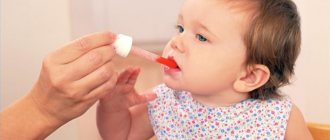October 03, 2018
Averyanova Sveta
A common life event for us is chickenpox in childhood. People get sick while visiting kindergarten and try to get infected in order to gain immunity at an early age. Typically, children with chickenpox suffer from rashes on the torso and perineum.
Can there be chickenpox in the mouth? Yes! This is an extremely unpleasant condition for children, since the presence of papules on the mucous membrane is the first sign of a severe form of the disease. What to do if chickenpox is in the mouth, how to recognize and treat the disease in children, we will tell you in our article.
How the process develops and proceeds
The viral agent that causes chickenpox has a melodious name - varicella zoster. It is very volatile, so it is easily transmitted through the air through saliva. Dr. Komarovsky claims that you can become infected from a neighbor on the first floor if you live on the fifth and entered the stairwell at the same time.
Once in the human body, the infection takes hold in the respiratory tract and multiplies quickly. Her next stop is lymph and blood. Here the virus feels great and spreads throughout all organs and structures.
The disease occurs in several stages.
Incubation period
Lasts 1–3 weeks. The duration depends on the child’s immunity. Towards the end of the latent stage, the first pimples appear on the patient’s body. With a serious course of the infectious disease, the localization of papules is concentrated in the mouth, on the mucous membrane of the throat, under the tongue. The first pimples are few, but they are bright red in color and are located on the cheeks and tonsils.
Acute stage
The rashes are becoming more and more frequent.
The baby develops a high temperature, fever, weakness, sore throat, itching, and insomnia.
Chickenpox papules on the oral mucosa are covered with blisters with liquid inside. The throat is swollen and very sore. In 3–5 days, the pimples burst, leaving weeping wounds. They cause discomfort to the child when eating, they pinch, itch, and ache when touched.
It is in the acute stage that children are at risk for secondary infection of chickenpox wounds in the mouth. Pimples are open to viruses and pathological bacteria. The infection process can provoke caries, chronic throat diseases, adenoids, and sore throat.
Recovery
There are fewer red spots, new ones do not appear. Weakness, ailments, and pain in the tonsil area go away.
Complications and consequences
Chickenpox in the mouth can cause a number of complications if preventive measures are not taken. Ulcers on the mucous membrane, formed after pimples burst, provide a breeding ground for pathogenic microflora.

If a child constantly puts his hands in his mouth or forgets to rinse his mouth after eating, bacteria settling in the wound begin to multiply rapidly.
If a child constantly puts his hands in his mouth or forgets to rinse his mouth after eating, bacteria settling in the wound begin to multiply rapidly and lead to infection, which can only be cured by long-term antibiotic therapy.
The risks of complications are high in patients with chronic respiratory diseases or acute adenoiditis, inflammation in the throat, which is accompanied by chickenpox.
Where does chickenpox occur in the mouth?
Chickenpox on the oral mucosa is a rare occurrence for children of kindergarten and primary school age. But you cannot insure yourself against a serious form of the disease. When diagnosing chickenpox, have your pediatrician carefully examine the child's mouth.
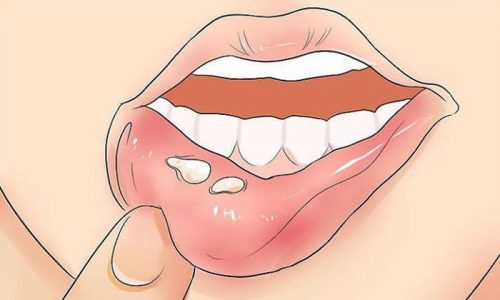
The most common places where ulcers are localized are:
- tongue and sublingual area;
- hard and soft palate;
- gum;
- cheeks;
- inner part of lips.
Important! Chickenpox papules on the mucous membrane do not become covered with a dark crust after opening, as on the body. They tighten and disappear in 2–4 days. This is explained by the high humidity of the oral cavity - a crust cannot form in such conditions.
What does it look like
The rash usually appears 1–2 weeks after the onset of the disease. Blisters affect the following areas: throat, tonsils, cheeks.
Chickenpox appears on the tongue last.
The sores first have a bright red tint, then become covered with a thin film with liquid inside. Children's vavki are never enormous in size. The rash is small, like urticaria, but covers the cavity almost completely.
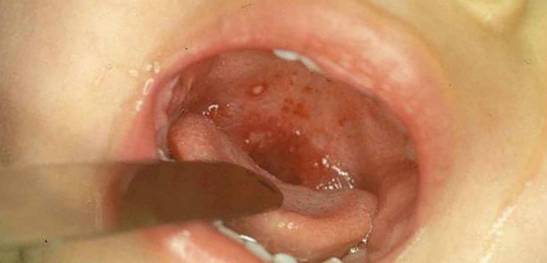
After 3–5 days, the first ulcers burst, but do not dry out. Wound healing is slow, and there is a risk of secondary infection. The most difficult thing for chickenpox to heal is in the throat, since the walls of the larynx are attacked by saliva, food, and drink. The wounds are cured at night while the baby is sleeping.
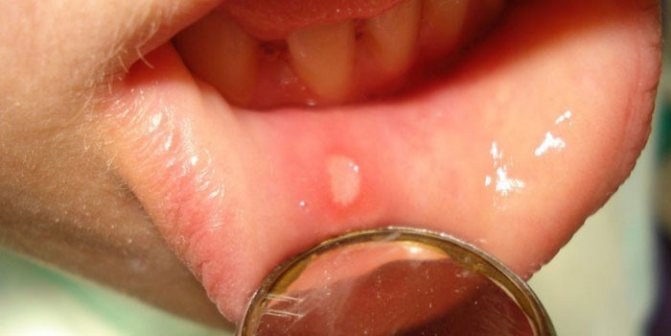
Important! If you notice a white coating, pus, stomatitis in your child’s mouth due to chickenpox sores, or the temperature rises again, consult a doctor immediately. The situation is out of your control and serious complications are possible.
Therapy begins with a trip to the doctor or calling a pediatrician at home. Chickenpox in the mouth can be treated at home according to the following scheme:
What do pimples in the mouth look like with chickenpox?
In the mouth, pockmarks can be localized in a variety of places: on the hard palate and pharynx, chickenpox on the tongue, gums, on the inside of the lips and cheeks.
Knowing how to treat chickenpox in a baby’s mouth is not enough. It is important to be able to distinguish its symptoms. To determine the pathology, you should pay attention to small papules, which tend to quickly burst, turning into ulcers. Healing of such rashes in the mouth occurs gradually.
Pimples in the oral cavity significantly reduce the quality of life of the baby. The child cannot chew food normally and it hurts to swallow.
Important! If there is a severe cough, convulsions, or the child begins to choke while eating, then you must immediately call a doctor.
If viral elements appear in the area of the oral mucosa, this indicates that the disease is severe.
How to rinse
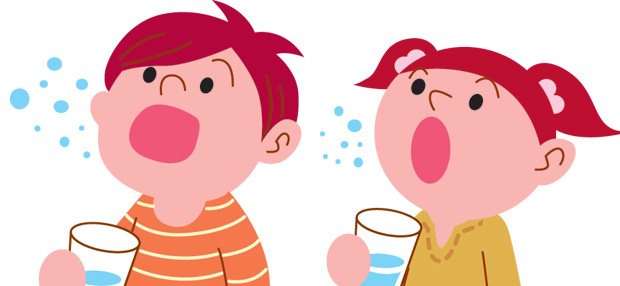
You need to rinse your mouth after eating and 4 more times a day. Use as medicinal rinses:
- "Miramistin spray." It is an antiseptic and wound-healing drug. Suitable for babies and allergy sufferers.
- Baking soda solution. Prepared from 1 tsp. soda and a glass of boiled water. The mucous membrane may tingle a little.
- Alcohol solution of boric acid. Stir 0.5 tsp. in 100 ml of water.
- Furacilin. Dissolve 1-2 tablets, cool. Prepare a new solution for each rinse.
- Potassium permanganate. For children, prepare a pale solution. Make sure that the rinse aid does not get into your stomach.
Principles of therapy
Treatment should be aimed at rapid healing of ulcers, elimination of pain, and prevention of complications.
Nutrition during the treatment period should be as chemically and mechanically gentle as possible.
If the baby is breastfed and refuses to breastfeed due to pain, the mother can express breast milk and feed through a nipple or syringe.
For older children, food should be semi-liquid: homogenized soups, slimy porridges, jelly, yoghurts, fruit purees, so that the child does not have to chew and it is easier to swallow.
Necessary:
- Eliminate all salty, sour, spicy, and canned foods from your diet.
- Increase the amount of liquid.
- Make drinks from rosehip infusion and dried fruits.
- Prepare compotes, jelly, weak tea.
- After eating, rinse your mouth thoroughly with boiled water. If the child is small, just give him clean water to drink.
Drug therapy
Local treatment consists of treating the elements of the chickenpox rash in the child’s mouth with various antiseptics and regenerating drugs.
Alcohol-containing preparations are not used to treat chickenpox stomatitis in children due to the risk of forming a deep chemical burn on the oral mucosa. A solution of brilliant green (zelenok) can be used to treat chickenpox rash only on the skin.
Up to 3 years of age, a child is not able to rinse his mouth, so at this age it is permissible to treat aphthae locally with a cotton swab 3-4 times a day after meals and at night. Use antibacterial, healing and painkillers:
- 2% solution of baking soda (a teaspoon per glass of boiled water).
- Rosehip oil, sea buckthorn.
- Chlorophyllipt oil solution.
- Kalgel (you can smear the aphthae no more than 2-3 times a day).
Other topical treatment options:
- From 3-5 years of age, a child’s oral cavity is treated with Miramistin in the form of a spray. The drug should be sprayed onto the mucous membrane of the tongue or cheeks. The medicine will then be distributed in the mouth and will act for several hours.
- Rinse with a diluted alcohol solution of Chlorophyllipt at the rate of 1 teaspoon of the drug per 100 ml of boiled water.
- An aqueous 0.02% solution of Furacilin is used to rinse the oral cavity: dissolve 1 tablet of Furacilin (0.5 g) in 200 ml of hot water.
- A weak solution of potassium permanganate (potassium permanganate). Several grains are dissolved in 500 ml of water to obtain a pink solution. Filter before use.
- Lizobakt tablets - local antiseptic for children over 3 years old, 1 tablet 3 times a day; over 7 years old – 4 times a day. It is used in the form of lozenges.
Folk remedies
Chickenpox can be treated using traditional methods with the permission of a doctor . Many plants have anti-inflammatory, antibacterial and healing effects. A very important advantage of natural remedies is their safety. Even if a child swallows the infusion, poisoning will not occur.
If the child is not allergic to bee products, a good effect is observed if the mouth ulcers are smeared with propolis.
To make infusions and decoctions, it is recommended to buy raw materials only in pharmacies, and not in markets from random people. Pharmacies receive only certified products that do not contain mold and harmful impurities in the form of lead and other heavy metals.
Infusions and decoctions for rinsing with chickenpox stomatitis are prepared from chamomile flowers, calendula, sage, alder fruits, birch buds, string grass, and yarrow.
The principle of making infusions: 1 dessert spoon of raw materials is poured with a glass of boiling water, infused for 30 minutes, filtered. The solution is ready for use. Infusions cannot be stored even in the refrigerator, and fresh ones should be prepared each time. In pharmacies, medicinal herbs are packaged in separate bags.
The mucous membranes of the oral cavity have a better ability to regenerate than the skin. It is quite difficult to cure chickenpox rash in the mouth due to poor accessibility to the affected areas for treatment and the capriciousness of children. But if all the doctor’s recommendations are followed, the treatment ends successfully, the mucous membrane is completely restored without scars or deformations.
How to treat and anoint
Mouth ulcers cause more discomfort to a child than rashes on the body. The mouth hurts, irritated by food, drink, saliva. Exanthems need to be healed quickly. You can anoint your mouth with the following medications:
- "Chlorophyllipt". Heals wounds, relieves pain. Apply with a cotton swab to irritated areas.
- Solution of "Lysozyme" with novocaine. Rashes heal faster if you treat the wounds regularly. The medicine should be kept in the mouth for a couple of minutes, then spit out. The pain will go away in 1-2 minutes.
- Solcoseryl paste. Protector of mucous membranes from infections, activator of the body’s immune functions. Treatment is carried out 2-3 times a day until the ulcers disappear completely.
- "Kalgel". Safe even for newborns. Quickly relieves pain and aching gums. Can be used 3-4 times a day.
Traditional methods of treatment

Grandmother’s advice also helps you figure out what to put on chickenpox in your mouth so that the pain and discomfort goes away faster. To eliminate unpleasant symptoms, use the following recipes:
- You need to rinse your mouth with herbal infusions .
Brew any of these herbs in boiling water: clover, dandelion, chamomile, string, yarrow, wormwood. Keep in a closed container or thermos for 10–15 minutes. You need to rinse your mouth 2-3 times a day. - Another option is a weak alcohol tincture of herbs with an antibacterial effect. It needs to be diluted with boiled water: 1 tsp. per glass of water. Clean your mouth 3-4 times a day. The alcohol solution disinfects the gums, lips, cheeks, and prevents additional infection from ulcers.
- Warm, plenty of drink . Dried fruit compotes and herbal teas wash the cheeks, gums, and throat. Wash away harmful bacteria from the mucous membrane.
- Parsley infusion . The grass contains a lot of vitamin C, which is so necessary for immunity during chickenpox. The infusion is taken 1–2 tsp. three times a day. It’s easy to prepare: pour 2 tbsp. l. dry matter with a glass of boiling water and leave for 10 minutes. You can drink immediately after straining.
- Sea buckthorn oil . It is better to lubricate your mouth at night and once or twice a day 30 minutes after meals. The oil will relieve pain and speed up wound healing.
Important! You cannot burn mouth ulcers with alcohol solutions or brilliant green. These drugs will burn the mucous membrane, adding health problems to the child and troubles for the parents. To treat chickenpox in the mouth, only mild pharmaceutical or natural remedies are used.
Development and course of the disease
Initially, the patient’s general condition noticeably worsens, he suffers from weakness, fatigue, migraines, and often develops a fever. In parallel with this, rashes appear in waves. The initial stage of chickenpox development lasts no more than 3-6 days, but if we are talking about a severe form of the disease, it can last up to 10 days. Each new attack of rash is accompanied by an increase in temperature, which is quite difficult to reduce.
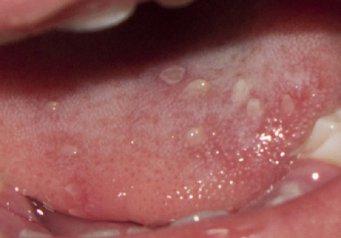
Chickenpox in children in the mouth and chickenpox in children on the tongue are easily curable today
Note! If a rash from chickenpox appears in the mouth, it means that we are talking about a severe form of the disease, since with a mild course there are practically no visible symptoms.
A rash in the mouth causes discomfort. This is something between stomatitis and a cold: it hurts the patient not only to chew, but also to swallow. But the main danger of a rash in the mouth is that it can lead to the development of a secondary infectious disease. In most cases, this reaction occurs with caries, inflammation of the tonsils, adenoids and other sources of infections. Moreover, ulcers may appear in the larynx and other mucous membranes of the respiratory tract, making breathing difficult. The risk of respiratory problems is especially high if some bacterial infection develops in parallel with chickenpox.

Photo of chickenpox in a patient's mouth
Nutrition

An ulcerative rash with this type of disease is localized in the most unfortunate place for a child. The baby feels pain constantly, and even more so when eating. To reduce trauma to the mucous membrane, parents need to take care of a special diet for the sick child.
What to include in your diet
Food for mouth ulcers should be soft and not require chewing.
Include the following dishes on the menu:
- porridge with water, milk;
- broths;
- grated salads dressed with oil;
- compotes, herbal teas;
- yoghurts, curds without fruit additives;
- bananas;
- legumes;
- stewed cabbage with meat;
- eggs.
Children of kindergarten age at the initial stage of the disease completely refuse food for 2-3 days. During this period, take care of the amount of liquid your child drinks, add sugar and milk to tea to increase the calorie content of the drink. An appetite will appear when the acute period ends, the papules begin to heal, and the temperature drops.
What foods should you not eat?
Be sure to exclude the following set of drinks and dishes from your child’s diet:
- sweets: chocolate, cookies, ice cream, etc.;
- soda;
- natural juices from sour fruits;
- salty;
- roast;
- smoked;
- spicy;
- solid foods: nuts, seeds, crackers, etc.
The list of prohibited foods includes all foods that irritate the mucous membranes with acid and injure the tongue, gums, and throat when consumed. The oral cavity requires maximum rest during illness.
Meal schedule
A sick baby should eat 4-5 times a day in small portions. Forget about a two-course meal and compote with cookies afterwards. Prepare one dish for each meal; be sure to cool it to room temperature. Give the drink 10 minutes after eating so that the herbal infusion, tea or water washes away bacteria and food debris from the larynx, gums, and tongue, acting as a therapeutic rinse.
The main symptoms of chickenpox
The initial stage of an infectious disease cannot be determined with accuracy, since it occurs latently. This process is called incubation. For several weeks, pathogens reside in epithelial cells in the mouth and nasopharynx, gradually multiplying and penetrating into the circulatory system through the lymph nodes.
Herpes zoster agents have their own DNA, so the immune system produces antibodies to effectively resist. But it takes time for them to become enough to fight. This is about 5-7 days from the beginning of the acute period of chickenpox.
Read: Chickenpox on the eyes
Having spread in the human body, viruses settle in skin cells, forming pink spots of destroyed capillaries. A rash is the main and characteristic sign of chickenpox. By its appearance, a doctor can immediately diagnose a herpes infection in a patient. After all, each pimple has certain stages of formation:
- small spots on the face, head, stomach;
- papules - transparent blisters that rise above the surface of the skin;
- vesicles - burst bubbles with a weeping structure and a red rim around the edge;
- crusts are dried blisters on which there are no longer active pathogens.
In addition to elements of the rash on the epidermis of various parts of the body, damage to epithelial cells is possible. Chickenpox in the mouth, eyelids, eyeball, and genitals appears quite often in people with poor health. Along with rashes, during periods of exacerbations their body temperature rises to high readings of 38-39 C. Moreover, some adults experience febrile states, severe intoxication and muscle weakness.



